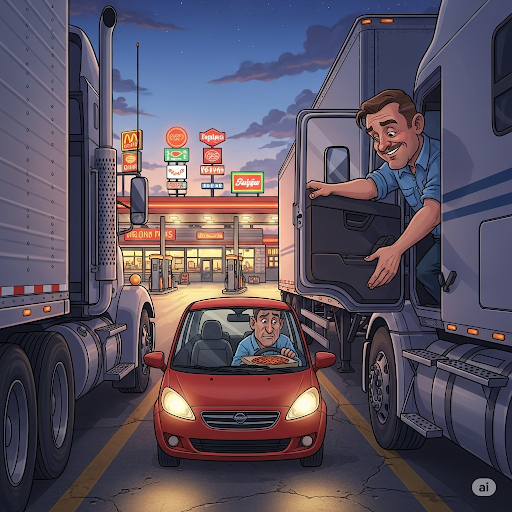
You’re parked for the night, the engine’s off, and your stomach is rumbling. The truck stop diner menu is looking a little tired, and you’re not in the mood for another microwaved burrito from the convenience store. A new option has emerged for the modern hauler: food delivery apps like DoorDash, Uber Eats, and Grubhub. They promise a world of culinary options right to your rig. But is it the ultimate convenience, or a financial and nutritional trap? Let’s break down the pros and cons.
The “Pros”: A Taste of Convenience
- Expanded Options: The biggest draw is the variety. Instead of being limited to whatever is on offer at the truck stop or nearby fast-food joints, you can access a huge range of local restaurants, from authentic Mexican to a decent pizza place or a healthier sit-down spot.
- Time-Saving: If you’re out of hours and don’t want to walk or drive to a restaurant, a delivery app brings the food right to you. This is a huge benefit, especially in inclement weather or when you’re simply exhausted.
- Late-Night Availability: Many food delivery services operate later than traditional truck stop restaurants, offering a lifeline for drivers who pull in late at night.
- A “Home-Cooked” Feeling: For drivers who spend weeks on the road, getting a meal from a local, non-chain restaurant can be a welcome change of pace and feel a little more like a treat.
- Self Pick up: While you might be able to drop your load and take you unit to a restaurant you will face parking at the restaurant ( you will need a little more space than a 4 door compact sedan ) and you might face pushback from the truck stop.
The “Cons”: Hidden Costs and Unhealthy Habits
This is where the real trucker’s wisdom comes in. The convenience of a delivery app comes at a price—and we’re not just talking about the money.
Financial Concerns
- The Sticker Shock: That $15 burger can quickly turn into a $30+ expense. Delivery apps add a number of charges that add up fast:
- Delivery Fees: A flat fee to get the food to you, which can vary wildly.
- Service Fees: A percentage of your total order, often 15-30% or more, that goes to the app company.
- “Small Order” Fees: If you don’t meet a minimum, you’ll be charged an extra fee.
- Surge Pricing: During busy times, you may be hit with an additional fee.
- Tips: You’re expected to tip the driver, which is an additional cost.
- Restaurant Up Charges: Because the delivery app charges the restaurant a fee, many diners charge more for delivery orders than for in store orders. A $12.99 entree in ordered in house could be $14.99 or $15.99 on the app. PLUS all the above add-on expenses.
- The “Truck Stop Tax”: Many drivers have found that delivery drivers may refuse to deliver to a remote truck stop or charge a premium for the extra distance. You also have to consider the risk of a driver getting lost or refusing to enter a large lot, potentially leaving you with no food and a difficult refund process.
- Cost vs. Benefit: When you compare the cost of a delivered meal to the price of cooking in your cab, or even eating at the truck stop diner, the price difference can be staggering. Over a few meals, the extra fees can add up to a significant portion of your weekly budget.
Nutritional and Dietary Concerns
- The “Junk Food” Trap: While delivery apps offer a wide range of options, they often make it too easy to default to unhealthy comfort foods like pizza, burgers, and fried chicken. These meals are often high in calories, sodium, and unhealthy fats—a recipe for health problems for a sedentary profession like trucking.
- No Control Over Ingredients: When you cook for yourself, you know exactly what’s in your food. With a delivered meal, you have no control over the ingredients, portion sizes, or cooking methods. This can be a serious issue for drivers with dietary restrictions, such as diabetes or high blood pressure.
- The Inconvenience of “Healthy”: Finding healthy options on these apps can be difficult and they may not be as readily available as fast-food chains. Even when you do find a “healthy” option, like a salad, it can often be loaded with high-calorie dressings, cheese, and fried toppings.
- The Meal Kit Alternative: While not as immediate, some services cater specifically to truckers by delivering pre-packaged, healthy meals directly to truck stops or home addresses, offering a much healthier and often more affordable alternative.
- The Drug Store or Dollar Store Option: One often overlooked option is, depending on the time of day, placing an order thru an APP for an order from a drug store or dollar store where you maybe able to order basic ingredients for sandwiches or a low prep meal. Still more expensive than picking up yourself but maybe cheaper while getting enough to make several meals.
Conclusion: Is It Worth It?
Food delivery apps at a truck stop can be a lifesaver in a pinch. If you’re in a city with limited food options and you’ve got money to burn, the convenience can’t be beaten. However, for the average hauler, the financial and nutritional costs are significant. A smart driver knows that the real long-term savings—and the key to staying healthy on the road—come from planning ahead, stocking your cab with a portable cooler and cooking essentials, and making a habit of smarter food choices.
So next time your stomach growls, ask yourself: Is the convenience of a delivered meal worth the “truck stop tax” on your wallet and your health?
Do you have a delivery funny or horror story you would like to share??? Please drop in the comments below.
Comments